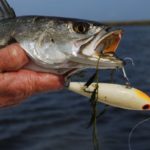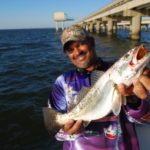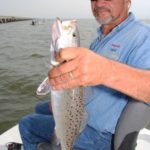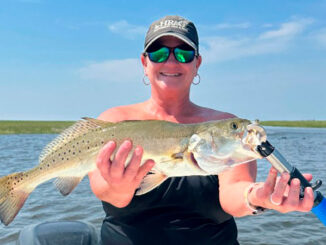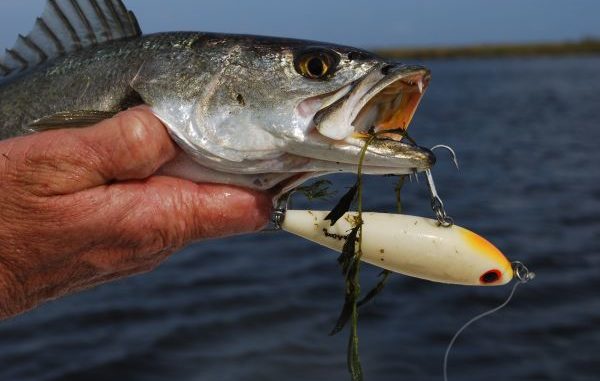
With the frigid temperatures of winter in the rearview mirror, anglers are looking to put some trout in their freezers. Here’s what to expect as you hit your favorite areas.
April is here at last—time for any red-blooded coastal fisherman to start thinking about the fish.
The fish?
Yeah, the fish — speckled trout.
It’s been a long winter; it’s been a cold winter; it’s been a windy winter. Everyone is itching to see what spring will bring.
To take an informed peak into the future, Louisiana Sportsman has divided the Louisiana coast into seven trout fishing areas and picked two speckled trout fishing experts from each area to give their perspectives on the outlook for 2014.
From east to west here are your best bets.
Lake Pontchartrain
On the extreme eastern end of the state, Lake Pontchartrain has developed a reputation for producing dependable catches of trophy-sized speckled trout.
Not so last year.
Dudley Vandenborre of Captain Dudley Vandenborre Fishing Guide Service (985-847-1924) — undeniably the dean of Lake Pontchartrain fishing guides — said 2013 was a low spot in the lake’s fishing history.
“Last year was the poorest year I have ever had for speckled trout in the lake, except for undersized fish,” Vandenborre said.
Eric Dumas of Living a Dream Guide Service (985-705-1244) agreed.
“It was probably one of my most difficult years,” Dumas said. “I would catch them one day in a spot, and then they would move to another spot the next day.
“When you did find fish, they were in small numbers.”
The large numbers of small speckled trout last year astounded Vandenborre.
“Areas that we never threw fish back because size, like the green pilings in the center of the railroad bridge, produced undersized fish every cast,” he said. “I mean way undersized — 8 or 9 inches long.
“They were so small that redfish would come up and grab them off your hook. The flats in mid-lake were just filled with small fish.”
Dumas saw much of the same.
Both men noted a slow start last spring. The peak, when it came in early May for Vandenborre and June for Dumas, played out quickly.
By the heat of the summer, live-bait time for Lake Pontchartrain, Dumas recalled that catching speckled trout was “like pulling teeth.” Catches would be a few as 12 to 15 fish per boat.
But the lake held plenty of other fish like drum, sheepshead and redfish — “trip-savers” is what Dumas called them. Vandenborre said the lake held more redfish than he has ever seen before.
Both men attribute the poor 2013 trout season to high freshwater discharges from the Pearl and West Pearl rivers that freshened Rigolets Pass and western Lake Borge enough that the fresh water acted a barrier to inward movement of shrimp.
“When we don’t see shrimpers in the lake, we don’t see shrimp — and when we don’t see shrimp, trout catches are slow,” Vandenborre said.
Both anglers recognized the devastating cold of this winter, but neither felt that it will negatively affect the 2014 trout season. Neither Vandenborre nor Dumas had heard of any fish kills due to cold weather in the Lake Pontchartrain area.
“I think that we will have a good year, —probably not a lot of big fish, but a lot of 1 ½-pound to 2-pound fish,” Vandenborre said.
He based his prediction on the large numbers of small fish he saw in 2013. But he added a caveat.
“I’m an optimist; remember that,” Vandeborre said.
Dumas agreed with Vandenborre’s assessment, but for different reasons.
He discounted the numbers of small fish he saw in 2013 as being indicative of the upcoming year, relying rather on the lake’s long-term record of productivity.
“If we don’t see the Pearl and West Pearl rivers come up and stay up, I am confident that we will see the usual run of bigger fish in the lake,” Dumas said.
Both rivers have remained low through mid-winter.
Dumas also shrugged off any concern of snow melt and runoff from the northern U.S. coming down the Mississippi River and forcing an opening of the Bonnet Carré Spillway.
“In years past, openings have usually been in late April and May,” he explained. “The big result of them has been that we just have to hunt harder for clean, high-salinity water.”
The spring and early summer recommendations from both men are very similar.
In April and May, the Tressels train bridge, the Highway 11 bridge and the Causeway bridge are where the trout will be, along with some on the I-10 twin span bridge.
During these months, fishing is done by casting soft plastics on jigheads as close as possible to the bridges’ pilings (called “poles” locally) and slowly working the lure dead on the bottom back to the boat.
Sometime in June, shrimp will become more common in the lake, and almost overnight catching fish on soft plastics becomes much more difficult. Live shrimp (and sometimes croakers) fished on Carolina rigs or under sliding corks become the order of the day.
Dumas noted that as live bait use becomes more prevalent, less fishing effort is put on the Causeway bridge.
With the arrival of July’s dog days, fishing in the eastern end of the lake shifts away from the three bridges down Rigolets Pass to the CSX Bridge and the small gas rigs of eastern Lake Borgne.
Click below for more great trout locations.
